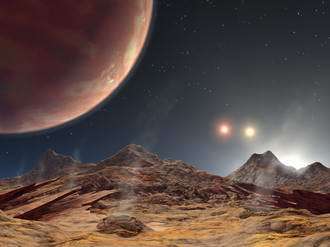First Planet Under Three Suns Is Discovered

An extrasolar planet under three suns has been discovered in the constellation Cygnus by a planetary scientist at the California Institute of Technology using the 10-meter Keck I telescope in Hawaii. The planet is slightly larger than Jupiter and, given that it has to contend with the gravitational pull of three bodies, promises to seriously challenge our current understanding of how planets are formed.
Image: This illustration shows an artist's conception of the three suns and the newly discovered Jupiter-sized planet from the perspective of a hypothetical moon orbiting the planet. The large yellow sun is already halfway over the horizon, but the orange and red suns are still visible in the sky.
In the July 14 issue of Nature, Maciej Konacki, a senior postdoctoral scholar in planetary science at Caltech, reports on the discovery of the Jupiter-class planet orbiting the main star of the close-triple-star system known as HD 188753. The three stars are about 149 light-years from Earth and are about as close to one another as the distance between the sun and Saturn.
In other words, a viewer there would see three bright suns in the sky. In fact, the sun that the planet orbits would be a very large object in the sky indeed, given that the planet's "year" is only three and a half days long. And it would be yellow, because the main star of HD 188753 is very similar to our own sun. The larger of the other two suns would be orange, and the smaller red.
Konacki refers to the new type of planet as "Tatooine planets," because of the similarity to Luke Skywalker's view of his home planet's sky in the first Star Wars movie.
"The environment in which this planet exists is quite spectacular," says Konacki. "With three suns, the sky view must be out of this world-literally and figuratively."
However, Konacki adds that the fact that a planet can even exist in a multiple-star system is amazing in itself. Binary and multiple stars are quite common in the solar neigborhood, and in fact outnumber single stars by some 20 percent.
Researchers have found most of the extrasolar planets discovered so far by using a precision velocity technique that is easier to employ on studies of single stars. Experts generally avoided close-binary and close-multiple stars because the existing planet detection techniques fail for such complicated systems, and also because theories of solar-system formation suggested that planets were very unlikely to form in such environments.
Konacki's breakthrough was made possible by his development of a novel method that allows him to precisely measure velocities of all members of close-binary and close-multiple-star systems. He used the technique for a search for extrasolar planets in such systems with the Keck I telescope. The planet in the HD 188753 system is the first one from this survey.
"If we believe that the same basic processes lead to the formation of planets around single stars and components of multiple stellar systems, then such processes should be equally feasible, regardless of the presence of stellar companions," Konacki says. "Planets from complicated stellar systems will put our theories of planet formation to a strict test."
Scientists in 1995 discovered the first "hot Jupiter"-in other words, an extrasolar gas-giant planet with an orbital period of three to nine days. Today, more than 20 such planets are known to orbit other stars. These planets are believed to form in a disk of gas and condensed matter at or beyond three astronomical units (three times the 93-million-mile distance between the sun and Earth).
A sufficient amount of solid material exists at three astronomical units to produce a core capable of capturing enough gas to form a giant planet. After formation, these planets are believed to migrate inward to their present very close orbits.
If the parent star is orbited by a close stellar companion, then its gravitational pull can significantly truncate a protoplanetary disk around the main star. In the case of HD 188753, the two stellar companions would truncate the disk around the main star to a radius of only 1.3 astronomical units, leaving no space for a planet to form.
"How that planet formed in such a complicated setting is very puzzling. I believe there is yet much to be learned about how giant planets are formed," says Konacki.
The research was funded by NASA.
Source: California Institute of Technology
















